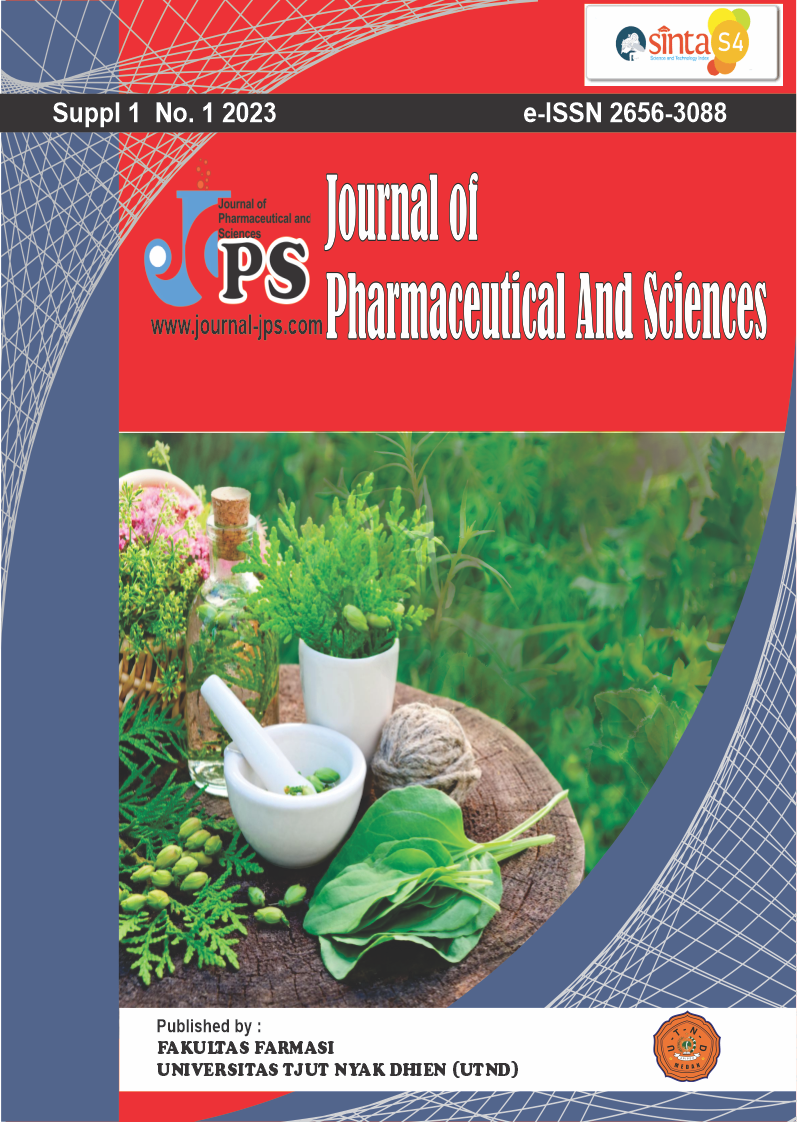Utilization of tannin extract from spent coffee ground (SCG) as a green corrosion inhibitor on ferrous metals in acidic and alkaline media
Main Article Content
Page: 168-176
Abstract
The inhibitory effect of spent coffee grounds (SCG) tannin extract as a corrosion inhibitor on ferrous metal in acid and alkaline media has been carried out. The results of evaluation the corrosion rate (CR) and inhibition efficiency (IE) in this study used the weight loss method. The Internasional Standard (SI) unit for calculating the corrosion rate was mm/year (mmpy). The results of the characterization of SCG tannin extract using Fourier Transform Infrared Spectroscopy (FTIR) showed that the functional groups were O-H, aliphatic C-H, C=O ester, aromatic C=C, C-O-H, and C-O-C ether which indicated the presence of tannin compounds in SCG. The results of the research showed that the maximum concentration of SCG tannin extract in inhibiting corrosion in acidic medium was 1000 ppm with an average CR of 2.2520 mmpy and an IE of 29.23%, while in alkaline medium it was 1000 ppm with an average CR 0.0592 mmpy and IE 50.93% for 5 days of soaking time, respectively. The surface morphology of the corroded ferrous metals was monitored with a USB digital microscope at 1000x magnification.
Downloads
Article Details

This work is licensed under a Creative Commons Attribution-NonCommercial-ShareAlike 4.0 International License.
References
Pusat Data dan Sistem Informasi Pertanian [PUSDATIN]. (2016). Statistik Konsumsi Pangan 2016. Sekretariat Jendral Kementrian Pertanian.
Susilayati, M., Marwoto, P., & Priatmoko, S. (2022). Characterization of Spent Coffee Grounds in the Community as Supporting Materials for Renewable Energy. Jurnal Penelitian Pendidikan IPA, 8(2), 918–924. https://doi.org/10.29303/jppipa.v8i2.1227.
Oko, S., Mustafa, M., Kurniawan, A., & Palulun, E. S. B. (2021). Pengaruh suhu dan konsentrasi aktivator hcl terhadap karakteristik karbon aktif dari ampas kopi. METANA, 17(1), 15-21.
Maysarah, Hilda; Desiyana, Lydia Septa; Nurzuhra, Siti; and Illian, Didi Nurhadi (2023) "Utilization of Spent Arabica Coffee Grounds as Raw Material for Activated Charcoal in Liquid Bath Soap Formulation," Pharmaceutical Sciences and Research: Vol. 10: No. 1, Article 5.
DOI: 10.7454/psr.v10i1.1282.
Sukmawati, S. H. and Sunarto, S. (2020). Utilization of Coffee Waste as Active Charcoal For Purification of Waste Cooking Oil. Indonesian Journal of Chemistry and Environment: Vol. 3: No. 2. doi.org/10.21831/ijce.v3i2.43510.
Bouhlal, F., Labjar, N., Abdoun, F., Mazkour, A., Serghini-Idrissi, M., Mahi, M. El, Lotfi, E. M., Skalli, A., & Hajjaji, S. El. (2020). Chemical and electrochemical studies of the inhibition performance of hydro-alcoholic extract of used coffee grounds (HECG) for the corrosion of C38 steel in 1M hydrochloric acid. Egyptian Journal of Petroleum, 29(1), 45–52.
Chismirina, S., Andayani, R., & Ginting, R. (2014). Pengaruh Kopi Arabika (Coffea arabica) Dan Kopi Robusta (Coffea canephora) Terhadap Visikositassaliva Secara In Vitro. Cakradonya Dent J, 6(2), 678–744.
Nardeli, J. V., Fugivara, C. S., Taryba, M., Pinto, E. R. P., Montemor, M. F., & Benedetti, A. V. (2019). Tannin: A natural corrosion inhibitor for aluminum alloys. Progress in Organic Coatings, 135(April), 368–381.
Ludiana, Y., & Handani, S. (2012). Pengaruh Konsentrasi Inhibitor Ekstrak Daun Teh ( C Amelia Sinensis ) Terhadap Laju Korosi Baja Karbon Schedule 40 Grade B ERW. Jurnal Fisika Unand, 1(1), 12–18.
Pratiwi, V. M., Yurista, R. B., Sulistijono, Kurniawan, B. A., & Maulana, F. A. (2020). Effect of variation concentration and soaking time on API 5L steel grade B in 3.5% nacl media using avocado seed extract inhibitors. AIP Conference Proceedings, 2262 (September).
Haryono, G., Sugiarto, B., & Farid, H. (2010). Ekstrak Bahan Alam sebagai Inhibitor Korosi. Prosiding Seminar Nasional Teknik Kimia “Kejuangan” Pengembangan Teknologi Kimia Untuk Pengolahan Sumber Daya Alam Indonesia, 1–6.
Shahadad Zainol Abidin and M Hazwan Hussin 2020 Mater. Res. Express. 7 016417. DOI 10.1088/2053-1591/ab663f.
Abdulmajid, A., Hamidon, T. S., Rahim, A. A., & Hussin, M. H. (2019). Tamarind shell tannin extracts as green corrosion inhibitors of mild steel in hydrochloric acid medium. Materials Research Express, 6(10).
Harianja, P., & Heltina, D. (2020). Pengaruh Konsentrasi H2So4 Terhadap Laju Korosi Dan Efisiensi Menggunakan Ekstrak Daun Salam (Syzgium Polyantha L). 7, 1–5.
Shivakumar, S. S., & Shetty, N. K., (2012). Ziziphus mauritiana Leaves Extracts as Corosion Inhibitor for Mild Steel in H2SO4 and Solutions, India. European Journal of Chemistry, 3(4), 426-432.
Yakubu, S. A., Rahim, A. A., Azmi, M. N., Awang, K., & Hussin, M. H. (2020). Comparative evaluations of antioxidant potentials of Dryobalanops aromatica tree bark extracts as green corrosion inhibitors of mild steel in hydrochloric acid. Materials Research Express, 6(12), 1265c4.
Sirajunnisa, A., Mohamed, M. F., Subramania, A., & Venkatraman, B. R. (2014). The inhibitive effect of Ziziphus jujuba leaves extract on the alkaline corrosion of aluminium. European Journal of Applied Sciences and Technology [EUJAST] Volume, 1(1).
Afandi, Y. K., Arief, I. S., & Amiadji. (2015). Analisa Laju Korosi pada Pelat Baja Karbon dengan Variasi Ketebalan Coating. Jurnal Teknik Its, 4(1), 1–5.
Ezeh, E. M., & Chinedu, A. P. (2023). Assessment of the corrosion inhibitory potentials of Chromolaena Odorata leaf extract on mild steel in hydrogen chloride acid environment. Moroccan Journal of Chemistry, 11(1), 11-1.
Yetri, Y., Sari, D. M., & Handani, S. (2016). Effisiensi Inhibisi Inhibitor Ekstrak Daun Teh (camelia sinensis) Terhadap Baja St-37 dalam Medium Asam dan Garam. Jurnal Katalisator, 1(1).
Rujiyanti, L., Kunarto, B., & Ery. (2011). Pengaruh Lama Ekstraksi Kulit Melinjo Merah (Gnetum gnemon L.) Berbantu Gelombang Ultrasonik Terhadap Yield, Fenolik, Flavonoid, Tanin dan Aktivitas Antioksidan. Teknologi Hasil Pertanian Universitas Semarang, 40.
Puspita Sari, P., Susanah Rita, W., & Puspawati, N. (2015). Identifikasi Dan Uji Aktivitas Senyawa Tanin Dari Ekstrak Daun Trembesi (Samanea Saman (Jacq.) Merr) Sebagai Antibakteri Escherichia Coli (E. Coli). Jurnal Kimia, 9(1), 27–34.
Pandia, A., Sumarni, W., & Annis, R. I. (2021). Pengembangan Alat Peraga Uji Daya Hantar Listrik Berbasis Stemdan Pengaruhnya Terhadap Literasi Kimia Peserta Didik. Chemistry in Education, 10 (1), 30–37.





